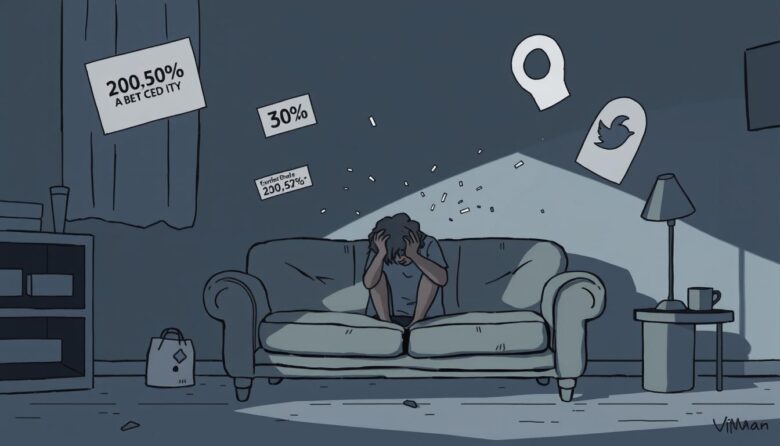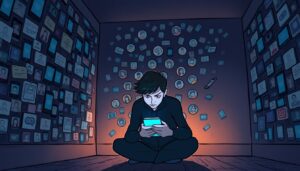Modern dating often feels like a marathon with no finish line. A Forbes Health and OnePoll survey reveals 79% of Gen Z adults feel drained by endless profile swiping. Singles Reports found similar patterns, with 78% of 18–54-year-olds reporting exhaustion from digital matchmaking efforts.
This phenomenon goes beyond typical frustration. Dating burnout occurs when the pressure to connect clashes with personal capacity. Unlike occasional fatigue, it’s a persistent state affecting decision-making and self-worth.
The digital landscape intensifies these challenges. Constant notifications and curated profiles create unrealistic expectations. Many invest hours scrolling yet struggle to form authentic bonds, creating a cycle that strains mental health.
Recognizing this pattern is crucial. Overexertion in dating apps often backfires, reducing the energy needed for genuine interactions. Understanding these dynamics helps individuals recalibrate their approach to relationships.
Understanding the Landscape of Modern Dating Burnout
The pursuit of love in the digital age has become a high-stakes numbers game. While dating apps promise convenience, they often leave users feeling depleted by endless scrolling and superficial interactions. This environment creates a unique form of exhaustion that mirrors workplace stress but targets personal lives.
What Defines This Exhaustion?
Dating burnout occurs when repeated efforts to connect drain mental resources. Like job-related strain, it involves chronic stress from unmet expectations. Small actions—crafting messages or planning meetups—start feeling like insurmountable tasks. Over time, this cycle erodes enthusiasm for building relationships.
The Swipe Fatigue Phenomenon
Modern apps design interactions to keep users engaged through gamification. Endless profiles turn potential partners into disposable options, fostering decision paralysis. A 2023 Pew Research study found 45% of app users feel overwhelmed by constant choices.
These platforms prioritize quantity over quality. Users juggle multiple conversations while maintaining curated profiles, creating pressure to perform. The result? Many people report feeling more isolated despite increased digital contact.
Recognizing these patterns helps break the cycle. Setting intentional limits on app usage allows energy preservation for meaningful connections. Balancing digital tools with real-world interactions remains key to sustainable dating habits.
Identifying the Signs of Emotional Exhaustion in Dating
Recognizing when relationship-seeking efforts start draining energy requires attention to behavioral patterns. Subtle shifts like dreading first meetings or avoiding profile updates often signal deeper fatigue. These markers help distinguish temporary frustration from persistent strain.
Overwhelm, Apathy, and Repetitive Interactions
Many notice their enthusiasm fading when planning meetups feels like scheduling dentist appointments. Swiping becomes automatic rather than intentional. Some cycle through deleting apps only to reinstall them days later—a pattern reflecting internal conflict between hope and frustration.
Conversations often stall at surface-level topics. “How was your weekend?” texts multiply without progressing to meaningful exchanges. This repetition breeds indifference, making genuine interest feel like effort rather than excitement.
Ghosting, Rejection, and the Cycle of Disappointment
Frequent cancellations or sudden silence from matches can heighten sensitivity to rejection. Relief when plans fall through reveals dwindling emotional reserves. Over time, these experiences create a defensive mindset that anticipates letdowns.
This cycle reinforces negative beliefs about relationship potential. People report increased irritability during interactions they’d previously found enjoyable. Recognizing these reactions early helps prevent long-term impacts on social confidence.
Managing Emotional Burnout from Dating
Regaining control starts with intentional digital habits. Structured approaches prevent swiping fatigue while preserving energy for real-world interactions.
Limiting Dating App Usage and Setting Boundaries
Experts suggest capping daily app sessions at 30 minutes. Schedule specific times for swiping rather than constant checks. Designate app-free days weekly to reset expectations.
Dr. Helen Fisher notes: “People binge, and that exhausts them.” Tracking screen time reveals usage patterns needing adjustment. Focus on deepening existing matches instead of chasing new ones.
Fostering Genuine In-Person Connections
Prioritize meeting potential partners quickly after initial chats. Shared activities like coffee walks create authentic bonds faster than endless texting. Quality interactions reduce digital overload.
Balance online efforts with community events or hobby groups. Face-to-face meetings filter compatibility more effectively than curated profiles. This shift helps rebuild enthusiasm for relationship-building.
Reflecting on Your Dating Habits and Relationship Goals
Clarity in dating begins with understanding your true intentions. Many struggle to recognize whether their actions align with their core desires or temporary impulses. A mindful approach helps bridge this gap.
Reassessing Intentions and Motivation
Start by asking: “Why am I using dating apps?” Is it for genuine connection or to fill empty time? Track patterns. Do you swipe when bored or anxious? Honest answers reveal if habits support long-term goals.
Create a list of five non-negotiable needs in a partner. This exercise filters mismatches early. For example, valuing shared hobbies might outweigh surface-level traits. Aligning choices with priorities reduces frustration.
Establishing Healthy Boundaries and Deal Breakers
Define three core boundaries before engaging with matches. Examples include communication frequency or dealbreakers like opposing life goals. These guardrails prevent energy drain from incompatible people.
Fear of being single often leads to settling. Remind yourself that temporary solitude fosters better decisions. Quality relationships thrive when both parties share mutual values and respect clear limits.
Revitalizing Personal Energy and Mental Health
Restoring vitality requires strategic pauses, much like athletes needing recovery days. Intentional breaks from relationship-seeking activities allow the mind to reset. Research shows stepping back improves clarity and renews enthusiasm for future connections.
Self-Care Strategies to Recharge Resources
Prioritize activities that spark joy without romantic pressure. Morning walks boost energy while evening journaling supports mental health. Creative projects like cooking or photography rebuild confidence through tangible achievements.
Socialize through group hikes or book clubs. These interactions maintain human connection without performance anxiety. Weekly screen-free hours create space for hobbies that nurture personal growth.
Taking Time Off to Restore Balance
Set clear timeframes for breaks—30 days often works well. Use this period to explore new interests that enrich daily life. Replace app scrolling with skill-building classes or volunteer work.
Many worry about missed opportunities during pauses. However, renewed energy leads to better decisions later. Return when excitement replaces dread, ready to form authentic bonds.
Incorporating Expert Insights and Evidence-Based Advice
Digital dating challenges demand evidence-based strategies to maintain mental well-being. Recent studies reveal why many struggle to sustain enthusiasm for app-based connections.
Research and Survey Findings on Dating Burnout
A 2023 Forbes Health survey highlights key stressors: 41% of users report ghosting, while 38% encounter catfishing. Over 40% struggle to find meaningful matches despite constant effort.
Swiping fatigue impacts 22% of users, with 24% drained by repetitive small talk. These patterns create cumulative stress that erodes confidence in relationship-building efforts.
Words of Wisdom from Relationship Experts
Dr. Helen Fisher warns: “Binge dating triggers cortisol spikes similar to workplace stress.” She advises limiting app sessions to 20-minute intervals for clearer decision-making.
The KMA Therapy team recommends addressing attachment styles through counseling. Their 15-year practice shows improved boundary-setting reduces mismatches by 60%.
Experts agree: Professional guidance helps reframe setbacks as learning opportunities. Combining data-driven insights with personalized strategies fosters healthier approaches to modern connections.
Moving Forward with Renewed Hope and Authentic Connection
Navigating modern relationships requires balance between effort and self-care. While digital fatigue may dim enthusiasm temporarily, rediscovering meaningful connections remains possible through intentional steps. Start by redefining success—one quality conversation often outweighs twenty swipes.
Prioritize interactions that spark curiosity rather than obligation. Set weekly limits on app usage, reserving energy for hobbies that fuel personal growth. These practices create space for authentic bonds to flourish naturally.
Remember: love thrives where pressure fades. Many find deeper relationships when approaching dating as self-discovery, not a race. Each experience builds clarity about what truly matters in lasting partnerships.
Carry forward strategies that resonate most—whether scheduled breaks or real-world meetups. Sustainable habits protect well-being while keeping doors open for genuine possibilities. With renewed hope, the right connection often arrives when you feel empowered, not exhausted.



